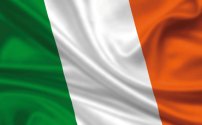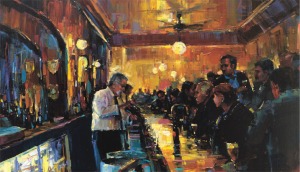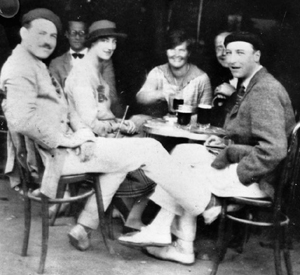We have a specific model of which we are to adhere to with this assignment. I’ll get to the meat of this assignment in a moment. But first, I wanted to throw in an aside, if I could, that I contemplated while we read our novel. You could call it my own personal journey through the pages of A Portrait of the Artist as a Young Man by James Joyce.
What does it mean to be Irish?
That’s a fair question, I think. I was born and raised in Texas being told of ancestors long ago traveling to the New World from Ireland to escape the Irish potato famine. With my maiden name as Dunn (I feel I might have been the only one of my classmates to notice the name of the butcher shop, Dunn’s of D’Olier Street, that Stephen’s father went to pick up the turkey for Christmas dinner ((Joyce 29))) and my mother’s surname is of Irish descent as well, I can remember, as a child, images of our family crests on the wall and tartan plaid blankets to honor our “clan”. On St. Patrick’s Day, I raise my pint of green beer and toast “Slainte” to the wonderment of my non-Irish companions. I giggle with pride over jokes like “Why did God invent whisky? ….So that the Irish wouldn’t rule the world.” With my blue eyes, auburn hair and pasty, almost transparent, skin, I paint a glossing fake Kelly green glaze over myself and claim to be Irish. However, upon reading A Portrait of the Artist as a Young Man, I had several epiphanic realizations worthy of Joyce himself. One is I have no more understanding what it is to be Irish than the Texan sitting next to me. My concept of Ireland and being Irish stems from watching movies as a child such as Darby O’Gill and the Little People and Finian’s Rainbow (The latter is a 1968 musical directed by, of all people, Francis Ford Coppola. Crazy, right?). I thought all Irishmen spoke with the same accent as the leprechaun from the Lucky Charms commercial and I truly did believe, for the longest time, that there really were leprechauns. I have a Disney-esque view of what the Emerald Isle is supposed to represent and, boy, was I wrong!
As I researched for this assignment, what I discovered in Irish history during Joyce’s writing of this novel was not flowing fields of clovers and a pot of gold at the end of the rainbow. I viewed videos and pictures from the Irish War of Independence that occurred between 1913 and 1923 of bombed out buildings reminiscent of similar photos I’ve seen of Berlin after the end of World War II. I labored over websites that were entitled “Women of the Easter Uprising of 1916” and viewed knickered-clad children playing in the streets with wooden guns behind sandbag barricades reenacting what they had witnessed. This was definitely no musical.
Also, during the reading of this novel, I developed a sort of kinship with the main character Stephen Dedalus. I saw a lot of me in him (and perhaps Joyce as well). A lot of the conscience journey that Stephen traveled; I have experienced myself as an amateur writer. Several, though not all, of his views about the world, life and religion correspond to my own. And dare I say it? I tend to reflect his narcissism from time to time as well (as my classmates might have realized in our Discussion Board posts). That’s a difficult pill to swallow. Do I consider myself an “artist” as the title suggests? I have never nor will I ever be comfortable being called an artist. Artists, in my mind’s eye, are stereotyped as tormented idealists that never can grasp the concept of reality or learn the adult responsibility of being able to move on from tragedy. They let it fester filling and consuming their lives and hearts with poisoned blood. Out of this inner turmoil, they release a beauty into the cold cruel world that it is lacking. With their small contribution, they feel it makes a better world to live in. However, for some artists, their work is not enough to sustain their own existence. The majority of elite master artists teetered between the brink of sanity and downright bat-ass crazy. Most had addictions that would help them escape from the reality that they loathed so much yet fueled their inner turmoil and their own self-loathing causing a paradox that no mere mortal or reasonably sane person could endure. So, please, never refer to me as an artist. Though I’ve seen flashes and echoes of what I’ve described in this paragraph within my own life, I’ve always been able to rationalize to myself the lunacy of it all and pull myself back to center. So, I must, after all, not be a “true artist”.
Now then, back to the assignment. Per our instructions we were to “Research four historical, political and/or cultural events pertinent to the period in which Joyce published his novel.”
Dublin
The first documented history of Dublin begins with the Viking raids in the 8th and 9th century. These led to the establishment of a settlement on the southside of the mouth of the Liffey, named Dubh Linn (Black Pool) after the lake where the Danes first moored their boats. (dublin.info). By the opening years of the 19th century, Dublin was home to over 150,000 people. Conditions for the poor who lived here were often appalling. It wasn’t until sewers were laid out throughout the city in the late 19th century that conditions improved for rich and poor alike. (word-guides.com) Today, Dublin is home to 1,273,069 people and accounts for 39% of the country’s population. (dubchamber.ie)
In Portrait of the Artist as a Young Man, Dublin marks a turning point in Stephen Dedalus’ life. It is the beginning of the end for Stephen. All of the wonderment and beauty of the world for Stephen seems to slip away when the Dedalus family is required to move from their comfortable home in the country to Dublin where Joyce would describe, “His sensitive nature was still smarting under the lashes of an undivined and squalid way of life. His soul was still disquieted and cast down by the dull phenomenon of Dublin.” (Joyce 74) Stephen would take note of “scum yellow waters” and “dark slimy streets” as his resentment to his family’s circumstances grew. He definitely is not the spokesperson for the Dublin Tourism Board.
I find it interesting that, as Joyce describes Stephen’s disdain for Dublin, Dublin is the setting for most of Joyce’s major works. Joyce lived in Trieste, Italy for 10 years and in Paris for 20 years. Why, then, does his literary work revolve around Dublin given his apparent resentment towards the capital city? To put it simplistically, it is home. You don’t have to like something to love it. Joyce never loses his sense of nationality displaying, although obscurely, a sense of pride concerning his homeland.
The Artistry of the Portrait
In 1874, a group of artists called the Anonymous Society of Painters, Sculptors, Printmakers, etc. organized an exhibition in Paris that launched the movement called Impressionism. The term “impressionism” was first coined to describe works that appeared sketchy and unfinished. Impressionists rejected the highly finished surfaces of academic painting of the time to create a visual language of bright, rapidly applied color to capture light and atmosphere. Impressionist painters developed a way of applying pigment that has been called “broken color” or “broken brushstrokes.” The paint is applied in mosaic-like patches which creates a rough irregular surface texture. Impressionists broke with the notion of academic finish by which paintings appear to have a flat or smooth surface. In an Impressionist canvas, paint is applied in thick a raised stroke which is called impasto. Through using thick brushwork an artist can create a roughened uneven texture that often mimics the texture of the subjects as well as captures and reflects light. (florencegriswoldmuseum.org)
James Joyce uses the technique of “stream of consciousness” in writing A Portrait of the Artist as a Young Man almost as a painter would use his brush to dab pigments of paint onto a canvas. I find the title rather prophetic, as well, to the reader as what to expect within the pages. The start of the novel is jerky and unclear with no clear sharp outline as to the characters or the setting. Joyce doesn’t go into great detail describing the characters giving a “sketchy and unfinished” feel to the reader. He provides “broken brushstrokes” to the reader to visualize, impressionistically, the scenes he writes about. He provides one stroke at a time for the reader and before the reader can realize it, has painted a picture of the world through Steven Dedalus’ eyes.
The Lost Generation
The term “the lost generation” was coined by Gertrude Stein who is rumored to have heard her auto-mechanic while in France to have said that his young workers were, “une generation perdue”. This refered to the young workers’ poor auto-mechanic repair skills. Gertrude Stein would take this phrase and use it to describe the people of the 1920’s who rejected American post World War I values. The three best known writers among The Lost Generation are F. Scott Fitzgerald, Ernest Hemingway and John Dos Passos. Others among the list are: Sherwood Anderson, Kay Boyle, Hart Crane, Ford Maddox Ford, Zelda Fitzgerald and Ezra Pound. Ernest Hemingway, perhaps the leading literary figure of the decade, would take Stein’s phrase, and use it as an epigraph for his first novel, The Sun Also Rises. Because of this novel’s popularity, the term, “The Lost Generation” is the enduring term that has stayed associated with writers of the 1920’s. (montgomerycollege.edu).
Some characteristics of “the lost generation” artists are youthful idealism, they sought the meaning of life, they reject spirituality, they drank a lot, they rejected American materialism in search for a more “bohemian” lifestyle and they, mostly, lived in Paris. This sounds remarkably like our resident artist, James Joyce. The only difference is that Joyce, perhaps, inspired his contemporaries and he was Irish, not American.
It was these young Modernists that, through their work, brought the world kicking and screaming through the constraints of moralist values and the devastation and shock of WWI. They presented new ideas and values that appealed to younger generation that were questioning the traditions of their parents. The Lost Generation showed them that it was ok to question the norm. It reminds me a lot of social change that occurred during the 1960’s during and after the Vietnam Conflict when societal view, once again, changed course.
The War to End All Wars
In June of 1914 when an Austrian Archduke was assassinated, the world would change forever. It was called “The War to End All Wars” and “The Great War”. Never in history had there been such a mass of military movement that involved so many countries. By the time World War I ended in November 1918, more than 9 million soldiers had been killed and 21 million more wounded.
However, with World War I raging, Ireland was fighting for its freedom as well. Three Irish divisions for a total of 210,000 men enlisted for the British army. They were the unionist 36th Ulster Division and two nationalists 10th Irish and 16th Irish Divisions. 35,000 Irishmen died in the conflict. I am curious as to why Joyce failed to mention such a significant world event within his novel or at least Stephen’s views on the subject.
After the Easter Rebellion of 1916 and 16 of the Nationalist leaders were executed, the attitudes of the Irish people seemed to change. In a more definitively nationalist Ireland, where many hearts had been thrilled by the valor of the men of 1916, there was no triumphant welcome home. It was as Tom Kettle, a former nationalist MP who was killed on the Somme serving with the 16th Division, had predicted. ‘These men’ (the 1916 leaders), he wrote, ‘will go down in history as heroes and martyrs; and I will go down – if I go down at all – as a bloody British officer.’ (bbc.co.uk)
Works cited:
Joyce, James. A Portrait of the Artist as a Young Man. eBook.
“A Brief History of Dublin, Ireland.” dublin.org. N.P. Web 19 Jun 2013. <http://www.dublin.info/history/>
“Dublin History Facts and Timelines.” world-guides.com. TravelSmart Ltd: World Guides Web. 22 Jun 2013. <http://www.world-guides.com/europe/ireland/county-dublin/dublin/dublin_history.html>
“Summary of the Greater Dublin Region.” dubchamber.ie. The Dublin Chamber of Commerce (Incorporated). Web 22 June 2013. <http://www.dubchamber.ie/policy/summary-of-the-greater-dublin-region>
“Characteristics of American Impressionism”. florencegriswoldmuseum.org. N.p. Web 22 Jun 2013. <http://www.florencegriswoldmuseum.org/learning/foxchase/html/about_impressionism.php>
“The Lost Generation: The American Writers of the ‘20’s.” montgomerycollege.edu. N.p. Web. 21 June 2013. <http://www.montgomerycollege.edu/Departments/hpolscrv/jbolhofer.html>
Jeffery, Professor Keith. “Ireland and World War One.” bbc.co.uk. 2011 Mar 10. Web. 19 June 2003. <http://www.bbc.co.uk/history/british/britain_wwone/ireland_wwone_01.shtml#four>



Jul 01, 2013 @ 18:26:53
Erin, Your blog was insightful and informative. I enjoyed reading about your family. It is interesting that Joyce set all of his works in Dublin, but lived most of his life overseas. He was quoted as saying “When I die Dublin will be in my heart.”-Robin Lehman